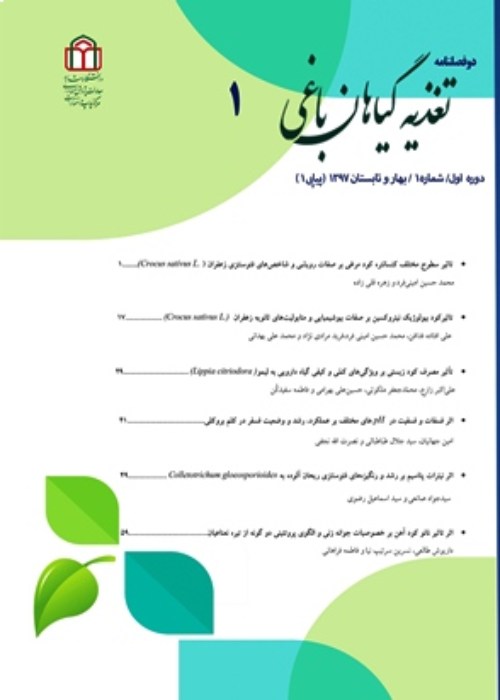Effect of irrigation interval, bio and non-biofertilizers on yield components and some of biochemical compounds in Thyme (Thymus vulgaris L.)
Aromatic Thyme (Thymus vulgaris L; Lamiaceae) is a valuable and common medicinal plant in traditional medicine. Due to its main composition, thymol, is used in the food, pharmaceutical, health and cosmetic industries. Among the different species of Thyme, Thymus vulgaris is cultivated and produced in many parts of the world, including Iran(Omidbaigi, 2000). Water stress can decrease leaf height, number and leaf area, dry weight,stomata closure, chlorophyll content reduction and root growth in medicinal plants. Therefore, it is important to deal with the damaging effects of drought in different ways such as the use of biofertilizers.
To investigate the effects of irrigation interval at three levels including W1=7(Control), W2=12 and W3=17 days irrigation interval as a main plot and bio and non – bio fertilizers at five levels including B1= control (without fertilizer), B2= Endo mycorrhizal (Glomus), B3= Azospirillum bacteria , B4= Pseudomonas bacteria and B5= chemical fertilizer(NPK) were considered as a sub plot on flowering branches yield , percentage of essential oil and some biochemical compounds in Thymus vulgaris, An experiment was conducted in a split plot design with randomized complete block design with three replications in 2017 in Asgarya agricultural field in Yazd. Finally, the data were analyzed through SAS statistical software and Excel software was used to draw charts. Means comparison was performed through LSD test at 5% probability level.
The results showed that the highest of flowering branches yield and total phenol were observed in control of irrigation (W1) and NPK treatment (B5), the highest of biological yield and number of lateral branches were observed in control of irrigation (W1) and mycorrhiza treatment (B2) , the highest of protein was observed in control of irrigation (W1) and Azospirillum treatment (B3), the highest of soluble carbohydrates was observed in W2 and pseudomonas treatment (B4), the highest of height was observed in control of irrigation (W1) , The highest of proline and the percentage of essential oil were observed in W3.In terms of fertilizer treatment, the highest of height, proline and the percentage of essential oi were observed in pseudomonas treatment (B4), NPK (B5) and mycorrhiza (B2). In general, the results in this experiment can be expressed, in terms of water deficit stress, use of biological fertilizers, especially mycorrhizal, can partly reduce the adverse effects on this plant.
In general, it can be concluded that the use of bio fertilizers, especially mycorrhiza, can reduce the side effects of this plant in water deficit conditions. According to the results of this study, it is concluded that accumulation of proline and carbohydrates in Thyme aerial parts in the face of water deficit stress, is one of the mechanisms of drought resistance in this plant. Rapid accumulation of osmotic pressure-regulating substances such as proline and carbohydrate decrease the osmotic potential of plant cells and thus water absorption of the plant. Also, similarity of yield increase and yield components of flowering shoots in Thyme with biofertilizers especially Mycorrhiza under stress conditions has positive effects of this fertilizer by improving physiological traits in the plant. Therefore, it seems that if the water deficit stress does not lead to a significant decrease in the economic performance of this plant, biofertilizers can be reduced on this plant.
- حق عضویت دریافتی صرف حمایت از نشریات عضو و نگهداری، تکمیل و توسعه مگیران میشود.
- پرداخت حق اشتراک و دانلود مقالات اجازه بازنشر آن در سایر رسانههای چاپی و دیجیتال را به کاربر نمیدهد.


